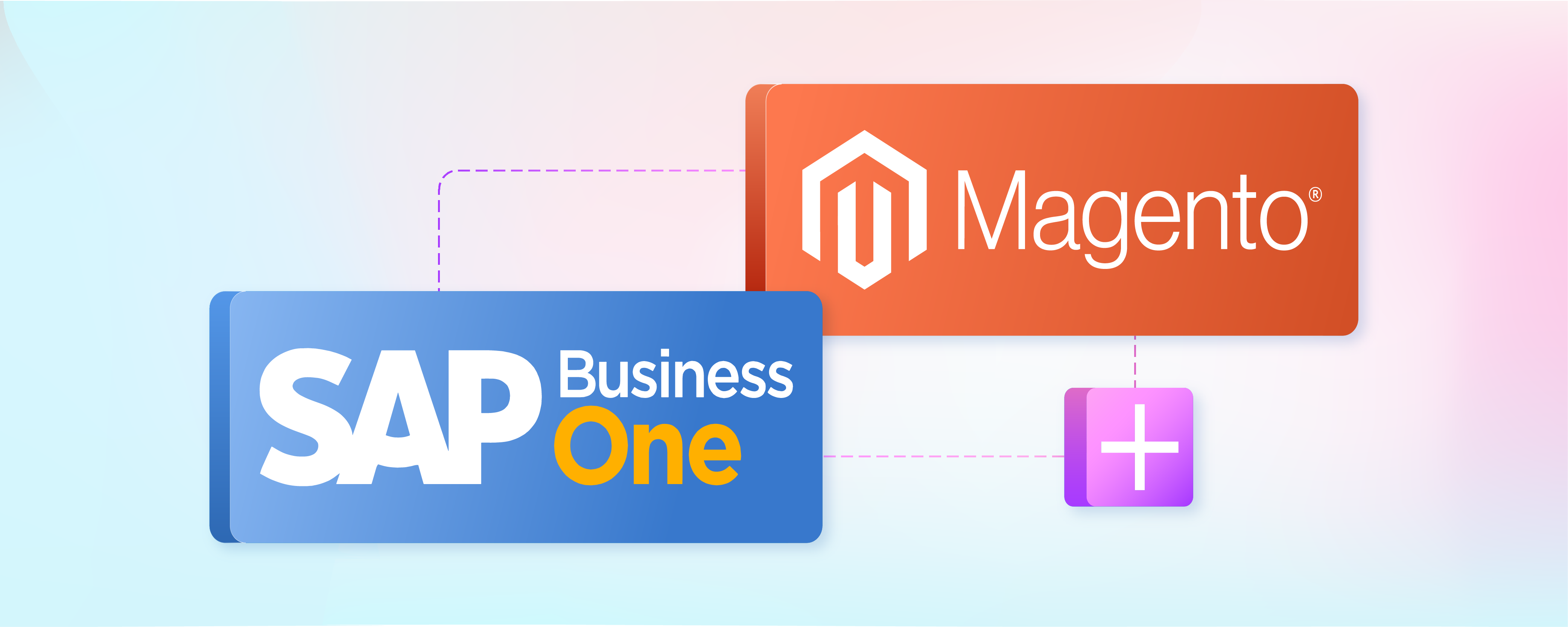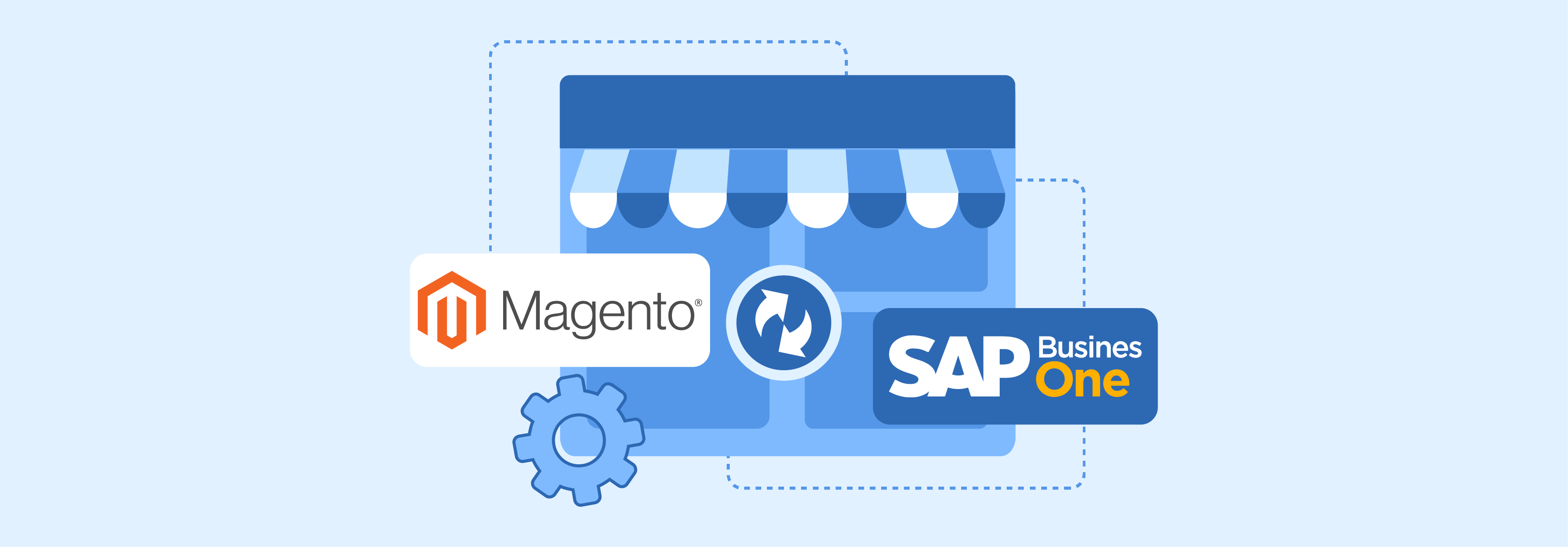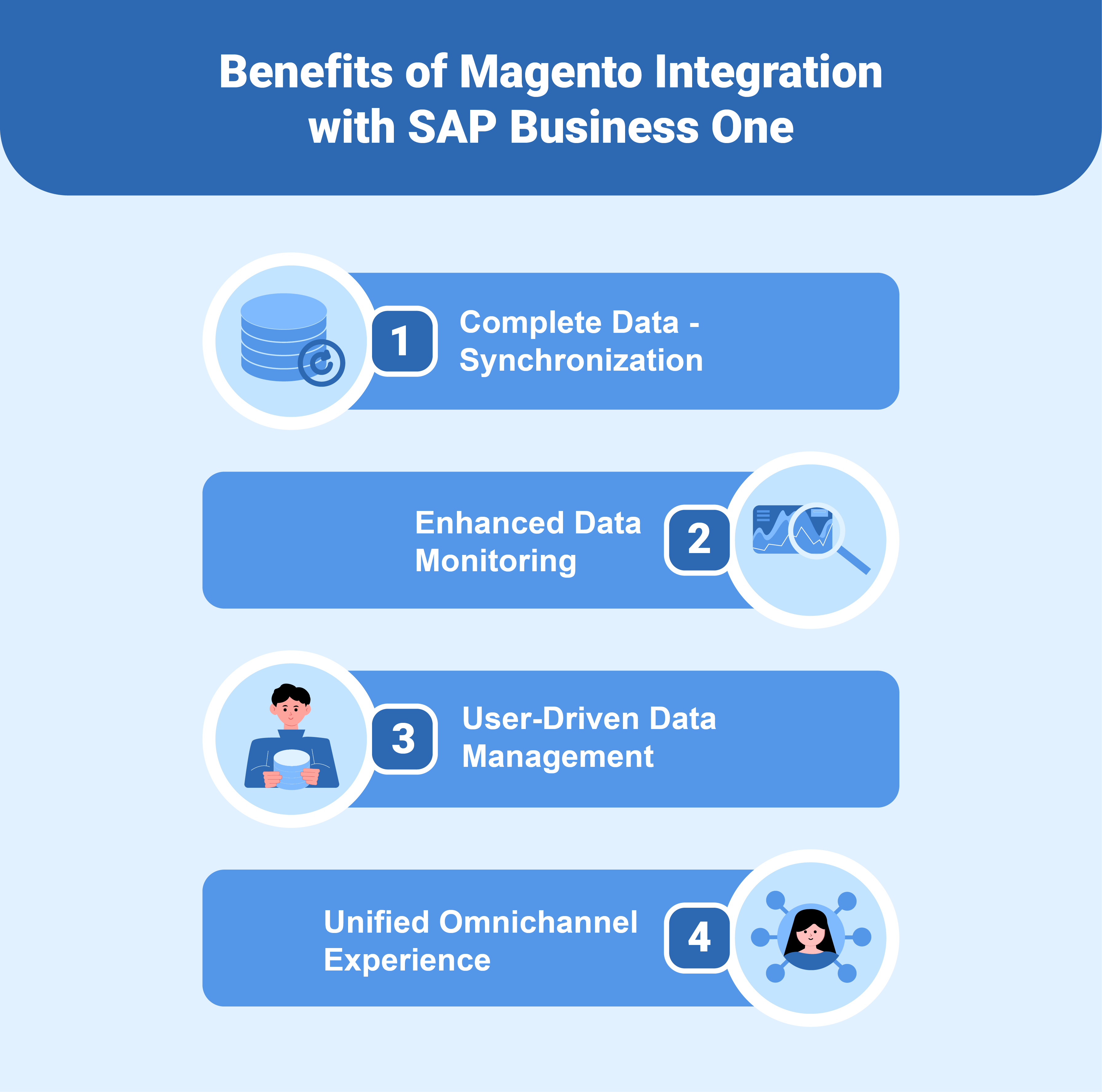
Why Connect Magento Integration with SAP Business One?
Are you looking to simplify your eCommerce operations? Magento integration with SAP Business One connects your store with an ERP system. It helps businesses reduce manual work and errors.
This article covers how Magento integration with SAP Business One improves business operations.
Key Takeaways
- 7 benefits of automating processes to ensure efficient data synchronization.
- Techniques to enhance eCommerce operations, optimize data management, and improve business processes.
- Insights into how Magento integration with SAP Business One simplifies business processes.
- 7 use cases for real-time synchronization between Magento and SAP B1.
- 10 key features of a solid integration connector.
- The role of APIs in Magento-SAP integration.
- Tips to ensure accurate inventory and order management with real-time data synchronization.
-
10 Features to Look for in a Magento-SAP Integration Connector
-
Common Scenarios for Magento and SAP Business One Integration
-
Real-world Examples of Successful SAP B1 Magento Integrations
-
How to Choose the Right Magento SAP Business One Integration Solution?
Understanding Magento Integration with SAP Business One

SAP Business One Integration with Magento 2 automates business processes. It handles tons of data, including orders, inventory, customer details, and invoices. Thus, it syncs everything, updates in real-time, and keeps your store running smoothly.
Magento SAP Business One is a powerful ERP system for small and mid-sized businesses. It centralizes operations, managing inventory, financials, sales, and customer relationships in one place.
Key features include:
- Real-time data sync: No more delays in updating orders/stock levels/customer details
- Automated workflows: Reduces manual data entry and eliminates errors
- Smooth ERP & eCommerce connection: Ensures smooth operations between your online store & SAP system
- Faster order fulfillment: Optimized processes improve customer experience
- Inventory management: Tracks stock levels in real-time
- Financial reporting: Generates reports on revenue, expenses, and sales
- Order processing: Automates purchase and sales orders
- Customer data management: Keeps all client details organized and updated
How Does Magento Integration with SAP Business One Work?
| Step | Description |
|---|---|
| 1. Connector Setup | Start by installing a reliable Magento 2 SAP Business One Connector. Connector tools operate independently, requiring no extra software installations. |
| 2. Job Creation | Create import and export jobs within the integration tool. Select key entities like orders, products, customers, and inventory. It lets you synchronize data between Magento 2 and SAP Business One. |
| 3. Configuration of Transfer Parameters | Define transfer parameters such as connection types, data sources, and formats. These settings ensure that data transfer processes are customized & accurate to your needs. |
| 4. Data Mapping & Filtering | Adjust imported or exported data using mapping settings and filters. It helps ensure compatibility between the two systems. This step guarantees that your data remains clean and usable in Magento 2 and SAP B1. |
| 5. Bi-directional synchronization | Enable bi-directional synchronization for entities like orders and inventory. It ensures real-time updates and allows smooth data flow in both directions. |
| 6. Establishing Connection | Use SAP's native API to establish a secure connection between the two platforms. Input credentials from your existing SAP Business One account. It enables you to authenticate and facilitate communication between systems. |
| 7. Automated Updates | Set up cron jobs to automate data updates, reducing manual intervention. It ensures that sensitive business data remains up-to-date in real-time across both platforms. Examples include stock levels or order statuses. |
| 8. Conflict Avoidance | Configure import behavior & mapping rules to avoid conflicts with in-store content/duplicate entries. This step eliminates discrepancies during the integration process, ensuring smooth operations. |
| 9. Synchronization Details | Synchronize the following sensitive data types efficiently: - Orders (Real-time) - Customers (Automatic) - Inventory (Live sync) - Products (Manual/auto sync) |
7 Benefits of Magento Integration with SAP Business One

1. Complete Data Synchronization
- Keep Magento 2 and SAP Business One in sync at all times.
- Changes in Magento instantly reflect in SAP B1 and vice versa.
- Real-time updates eliminate manual data entry errors.
2. Enhanced Data Monitoring
- Gain complete visibility into orders, inventory, and customer data.
- Detailed reports help track sales trends and system performance.
- Make data-driven decisions to optimize business operations.
3. User-Driven Data Management
- Automate import/export jobs with minimal manual effort.
- Easy setup and manage large data volumes.
- Optimize workflows with an intuitive interface.
4. Unified Omnichannel Experience
- Efficiently integrate across multiple Magento stores.
- Keep inventory, pricing, and customer data consistent.
- Manage multiple stores, warehouses, and offline locations effortlessly.
5. Improved Inventory and Order Management
- Track stock levels in real-time to avoid overselling.
- Automate order processing to speed up fulfillment.
- Reduce order errors with accurate data synchronization.
6. Faster and Automated Sales Order Processing
- Automatically sync sales orders between platforms.
- Generate invoices and shipment updates without delays.
- Enhance customer experience by providing accurate tracking info.
7. Reduced Manual Work and Errors
- Eliminate repetitive data entry tasks.
- Automation ensures accuracy and efficiency.
- Reduce human errors that lead to customer complaints.
Use Cases of SAP Business One Integration
| Use Case | Description | Benefits |
|---|---|---|
| eCommerce Integration | - Integrate with platforms like Magento, Shopify, and WooCommerce. - Sync customer orders, inventory levels, and product data in real-time. |
- Inventory Synchronization: Prevent overselling with up-to-date stock levels. - Automated Order Processing: Reduce errors and manual tasks. - Flexible Customer Data Sync: Align marketing, sales, and support teams. |
| CRM Integration | - Connect Salesforce, HubSpot, and Zoho CRM with SAP B1. - Centralize customer interactions, sales orders, and payments. |
- Unified Customer Data: Access purchase history, order details, and payment status. - Automated Quoting & Invoicing: Create sales orders directly from CRM leads. - Improved Support: Speed up resolution time with instant access to customer records. |
| Payment Gateway Integration | - Sync with PayPal, Stripe, and Square. - Simplify transactions, invoicing, and financial reporting. |
- Automated Reconciliation: Matche payments with invoices. - Transaction Tracking: Link every transaction to orders for auditing. - Better Cash Flow Management: Improve financial planning with real-time payment tracking. |
| Logistics & Shipping Integration | - Integrate with FedEx, DHL, and UPS. - Automate shipment tracking, delivery status updates, and accurate shipping cost calculations. |
- Real-time Shipment Tracking: Get updates instantly. - Automated Label Generation: Reduce time spent on manual shipping tasks. - Optimized Shipping Costs: Cut down unnecessary expenses. |
| POS Integration | - Connect SAP Business One with POS systems like Square, Lightspeed, and Clover. - Sync retail sales, inventory, and financial records in real-time. |
- Live Sales Data Sync: Update ERP records instantly with POS sales. - Automated Inventory Management: Adjust stock levels dynamically after each sale. - Efficient Financial Reporting: Auto-sync daily sales with accounting systems. |
| Inventory & Warehouse Management | - Integrate with tools like Fishbowl, Netstock, and 3PL providers. - Get control over your inventory, reordering, and warehouse operations. |
- Optimized Stock Levels: Prevent overstocking and stockouts. - Faster Order Fulfillment: Reduce processing times and improve efficiency. - Automated Reordering: Trigger purchase orders when stock drops. |
| B2B Integration | - Integrate SAP Business One with Magento B2B features. - Handle bulk orders, special pricing, and B2B transactions. |
- Business Partner Sync: Keep suppliers, vendors, and buyers connected. - Automated Order Processing: Simplify bulk purchase handling. - Better Account Management: Maintain separate pricing and contract terms for B2B clients. |
10 Features to Look for in a Magento-SAP Integration Connector
1. Real-Time Synchronization
The connector must enable real-time data synchronization, such as orders, inventory, & customer information. It ensures that Magento & SAP Business One remain up-to-date, eliminating delays & manual updates.
2. Support for B2B and B2C scenarios
Your integration connector should cater to Magento's B2B and B2C business models. The connector should handle these scenarios effortlessly, whether it's syncing:
- Customer-specific pricing
- Bulk orders
- Individual transactions
3. Flexibility for Customization
Every business is unique, so your connector should allow for custom workflows. It should also let you sync specific data types or configure one-way or two-way data flows. This flexibility ensures that the integration aligns with your business processes.
4. Bi-Directional Data Flow
A strong Magento-SAP integration connector supports bidirectional data flow. It allows flexible communication between Magento and SAP Business One. Thus, it eliminates manual data entry errors & ensures consistent information across both systems.
5. Multi-Entity Syncing
Sync multiple entities, such as products, categories, orders, invoices, customers, and inventory. An integrated connector ensures that all sensitive data points are synchronized without gaps.
6. Event-Based Triggers
Event-based triggers significantly enhance system efficiency. When an order is placed in Magento or stock levels change in SAP B1, the connector updates both systems.
7. Open-Code Architecture
Connectors with open-code architecture are ideal for businesses that require added flexibility. This architecture helps developers tweak the code to meet specific operational/security requirements.
8. Secure Data Transfer
Data security is non-negotiable. Choose a connector that avoids third-party servers during data transfers. It helps protect sensitive customer information and business data from breaches or losses.
9. Scalability for Growth
As your business grows, so do your integration needs. A scalable connector can handle increased data loads. It allows you to integrate stores or platforms without compromising performance.
10. Easy Configuration and Setup
Look for connectors that offer configured workflows or templates to simplify setup. It will reduce implementation time while ensuring compatibility with Magento & SAP Business One.
Common Scenarios for Magento and SAP Business One Integration
| Scenario | Description |
|---|---|
| 1. Syncing Sales Orders from Magento to SAP Business One | Automatically transfer sales orders, including customer details (new, existing, or guest accounts). |
| 2. Real-Time Product Updates | Update product details like SKUs, descriptions, pricing, stock levels, & tax classes in real-time. It helps ensure accurate inventory management. |
| 3. Payment and Transaction Sync | Automatically transfer online payment details and transaction IDs from Magento to SAP B1. |
| 4. Shipping Status Updates | Once invoices/deliveries are created, update Magento with a "complete" or "shipped" status. |
| 5. Inventory Management | Magento automatically creates purchase orders when stock levels fall below predefined thresholds. It helps ensure consistent inventory availability. |
| 6. Real-Time Alerts and Notifications | To keep your team informed and proactive, trigger email or SMS alerts for specific events. For example, low stock levels or errors in the sales process. |
| 7. Drop Shipping Integration | Automatically communicate Magento orders to fulfillment partners for drop shipping. It helps ensure timely order processing and delivery. |
| 8. Product Information Management (PIM) | Maintain consistency across all sales channels by synchronizing Magento & SAP B1 product catalogs. |
| 9. Customer Account Management | Sync customer accounts, including B2B and B2C profiles. Do this between platforms to manage customer data accurately and personalize customer experiences. |
| 10. Parcel Service Integration | Integrate with preferred parcel services like UPS, FedEx, or DHL. It helps simplify order shipment processes directly from SAP Business One. |
3 Methods for SAP Business One Integration
1. API-Based Integration
SAP Business One provides enhanced APIs. These APIs efficiently integrate with external platforms like Magento, Shopify, and CRMs. They expose SAP B1’s core functionalities. They also enable real-time data synchronization for inventory, sales, and financials.
Benefits
- Instant data sync between SAP and external systems
- Highly customizable workflows customized to business needs
- Scalable as business operations expand
Challenges
- Requires technical expertise for implementation
- Ongoing maintenance to keep integrations updated
Use Cases
- Sync Magento sales orders with SAP B1 for automated processing.
- Connect SAP B1 to Salesforce CRM to optimize customer data management.
2. ETL (Extract, Transform, Load) Integration
ETL tools include SAP Data Services, Talend, and Informatica. These tools enable batch data transfers between SAP Business One and other systems. They make them ideal for businesses with large datasets that don’t require real-time sync.
Benefits
- Handles massive data volumes efficiently
- Automates scheduled data transfers, reducing manual work
- Ensures clean and structured data entry
Challenges
- Not real-time; data updates occur in scheduled batches
- The initial setup is complex, requiring proper configuration
Use Cases
- Sync SAP B1 data with data warehouses for analytics.
- Configure periodic financial data transfer from SAP B1 to external accounting platforms.
3. Middleware Integration
Middleware platforms like Boomi, MuleSoft, and Celigo simplify SAP Business One integration. They provide pre-built connectors that automate data transfers without custom coding.
Benefits
- Faster implementation compared to custom API integrations
- Centralized monitoring of all integrations
- Real-time synchronization in most solutions
Challenges
- Higher cost than direct API connections
- The learning curve involved in configuring workflows
Use Cases
- Conduct real-time data sync between SAP B1 and Salesforce CRM.
- Automate inventory and order updates between SAP B1 and Magento.
Real-world Examples of Successful SAP B1 Magento Integrations
| Company | Challenge | Solution | Result |
|---|---|---|---|
| Arvato Supply Chain Solutions | High recruitment costs and dependency on external consultants | Integrated Magento with SAP Business One to automate inventory updates & simplify order processing | Achieved reduced operational costs due to faster and more accurate order fulfillment |
| Coca-Cola Europacific Partners (CCEP) | Needed to consolidate multiple career sites and differentiate from The Coca-Cola Company | Used SAP B1 integration to unify data & sales while optimizing workflows for a better UX | Doubled annual job applications & reduced application time by two-thirds, enhancing their employer branding |
| JewelEMarket | Struggled with inventory irregularities and slow order processing caused by disjointed systems | Automated real-time inventory updates & synchronized sales orders between Magento and SAP Business One | Reduced operational costs and improved stock visibility for better decision-making |
| Planet Jill | Needed smooth real-time sync between Magento & SAP B1 for rapid order fulfillment management | Implemented APPSeCONNECT integration platform to automate inventory, order, and customer data synchronization | Optimized operations, improved inventory management, & achieved bi-directional real-time sync of sensitive business data |
| Prana Biovegan Inc. | Struggled with managing sales orders post-migration from Magento 1 to Magento 2 | Designed custom business flows to automate the synchronization of orders, inventory, & customer data | Enhanced operational efficiency, reduced manual errors, and provided a smooth customer experience |
| Premier Research Labs | Required integration of Magento stores with SAP for efficient workflows across multiple locations | Automated syncing of customers, items, orders, and invoices for real-time bi-directional data transfer | Achieved faster order processing, allowing more focus on production planning and purchase management |
| Sea Magik | Needed to manage bulk orders globally while ensuring consistency in the product catalog | Fully automated product catalog synchronization to provide accurate product information | Improved order processing efficiency and established simplified operations for perpetual growth globally |
| Michael Miller Fabrics | Required smooth transfer of data across platforms for B2B & B2C business object mapping | Integrated Magento Enterprise store for syncing customers, items, orders, inventory, delivery, & invoice data | Consolidated all data within the system, reduced manual errors, and ensured real-time updates |
How to Choose the Right Magento SAP Business One Integration Solution?
| Factor | What to Look For |
|---|---|
| Automated Data Sync | Ensure the solution supports real-time synchronization for orders, inventory, customers, and products. It will eliminate manual updates and keep your systems in sync. |
| ERP Integration Capabilities | The connector should efficiently integrate SAP Business One with Magento. It must enable smooth data flow between Magento ERP and e-commerce platforms. |
| B2B and B2C Support | If you operate in both B2B and B2C markets, choose a solution that handles the following: - Customer-specific pricing - Bulk orders - Individual transactions |
| Multi-Store Capability | The integration should support syncing data across all stores without additional complexity. |
| Customization Options | Look for open-code or highly customizable solutions. These options allow you to customize workflows, data types, and synchronization directions. |
| Integration Method | Decide between: - API-Based Solutions: Use APIs for real-time integration and direct communication. - Middleware Platforms: Cloud-based platforms like iPaaS automate workflows and connect multiple systems. - Custom Solutions: Customize integrations designed for unique business requirements. But, doing so may require technical expertise. |
| Security Features | Choose a connector that avoids third-party servers during data transfer. It will help ensure the security of sensitive customer and business data. |
| Ease of Setup | Opt for solutions with pre-configured workflows or templates for quick setup. It does not require extensive technical knowledge. |
| Scalability | Ensure the integration can handle increased data loads, whether it’s more: - Products - Customers - Sales channels |
FAQs
1. How does SAP Business One improve eCommerce operations?
SAP Business One automates order processing and inventory updates across platforms. It reduces manual errors and speeds up fulfillment.
2. Can SAP Business One integrate with multiple eCommerce stores?
Yes, SAP Business One syncs data from multiple stores in real-time. It helps maintain consistent inventory and order accuracy.
3. What are the benefits of API-based integration?
SAP Business One allows instant data transfers and customized business workflows. Businesses can customize integrations to their unique needs.
4. How does middleware simplify SAP Business One integration?
Middleware offers ready-to-use connectors for automated data syncing. It minimizes the need for custom development and maintenance.
5. Is ETL integration suitable for real-time synchronization?
No, ETL works best for scheduled data transfers and large datasets. It’s ideal for batch processing and historical data migration.
6. Does SAP Business One integration support automation?
Yes, SAP Business One automates invoicing, order updates, and inventory management in Magento. It improves efficiency and reduces repetitive tasks.
7. What challenges come with SAP Business One integration?
SAP Business One requires setup, maintenance, and sometimes technical expertise. Choosing the right integration method can simplify implementation.
Summary
Magento integration with SAP Business One ensures data flow between Magento & SAP B1. With the right extension, businesses can:
- Improve accuracy and ensure real-time synchronization of sales orders, inventory, and customer data.
- Sync orders, inventory, and customer data in real-time for better efficiency.
- Optimize your eCommerce and ERP system operations.
- Ensure better customer experience with accurate order tracking and stock updates.
- Improve decision-making through centralized data management.
- Offer real-time data transfer, while middleware supports complex workflows.
- Use automation to reduce manual tasks and speed up order processing.
Consider Magento optimized server to sync multiple Magento stores with SAP Bussiness One.




